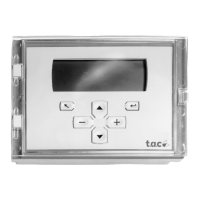
Do you have a question about the t.a.c. Xenta OP and is the answer not in the manual?
| Series | Xenta |
|---|---|
| Enclosure Material | Plastic |
| Protection Class | IP20 |
| Power Supply | 24 V AC/DC |
| Weight | 0.5 kg |
Overview of the TAC Xenta OP operator panel and its key features.
Details the content and structure of the TAC Xenta OP handbook.
Lists other relevant documents and resources for the TAC Xenta OP.
Details the physical characteristics and primary functions of the TAC Xenta OP operator panel.
Explains the physical connection of the TAC Xenta OP to the TAC Xenta 100 controller.
Details the connection methods for the TAC Xenta OP to TAC Xenta 300/401 controllers.
Describes the function of each push button on the TAC Xenta OP operator panel.
Explains how to access and use the local service menu for hardware checks and system parameters.
Guides on how to switch between communication modes for TAC Xenta 100 and Base units.
Provides procedures for de-installing the OP from the network using MetraVision or LonMaker tools.
Introduction to using the TAC Xenta OP for TAC Xenta 100 Zone Controllers and Network Variables.
Describes the process of establishing a connection between the TAC Xenta OP and the TAC Xenta 100 network.
Explains how to set the node state (Configured/Unconfigured) for the TAC Xenta 100.
Details how to select and view Network Variables (NVs) on the TAC Xenta 100.
Describes how to send a service pin message from the TAC Xenta 100 via the OP.
Explains the menu structure and principles for interacting with TAC Xenta 300/401 controllers.
Provides an example of navigating menus to find and modify a setpoint value for a controller.
Details how to view, acknowledge, and manage alarms displayed on the operator panel.
Explains how to adjust operating hours by modifying time channels and week schedules.
Describes access levels and how to enter or change the access code for menu items.
Details the process of changing the access code to enable higher access levels.
Explains how to manually override input and output values for controller points.
Covers the built-in support for European standard daylight saving time settings.
Describes the automatic log off procedure and how unsaved changes are handled.